🚀 It’s live! Access exclusive 2025 live chat benchmarks & see how your team stacks up.
Get the data🚀 It’s live! Access exclusive 2025 live chat benchmarks & see how your team stacks up.
Get the dataIn 2020, the North America chatbot software market was valued at $182 million. Fast forward to 2025 and it’s predicted to be worth over $580 million. The reason for this growth – over 200% in 5 years – is relatively simple.
Brands of all industries are beginning to recognize the huge benefits that chatbot apps can bring to their organization. Firstly, today’s consumers are increasingly demanding support that is fast and 24/7. Chatbot apps provide exactly this and, now powered by improved technology and AI, consumer acceptance is growing fast. 70% of customers either currently use or are interested in using chatbots for simple customer service enquiries. On top of this, 45% of consumers prefer chatbots as the primary mode of customer service communication.
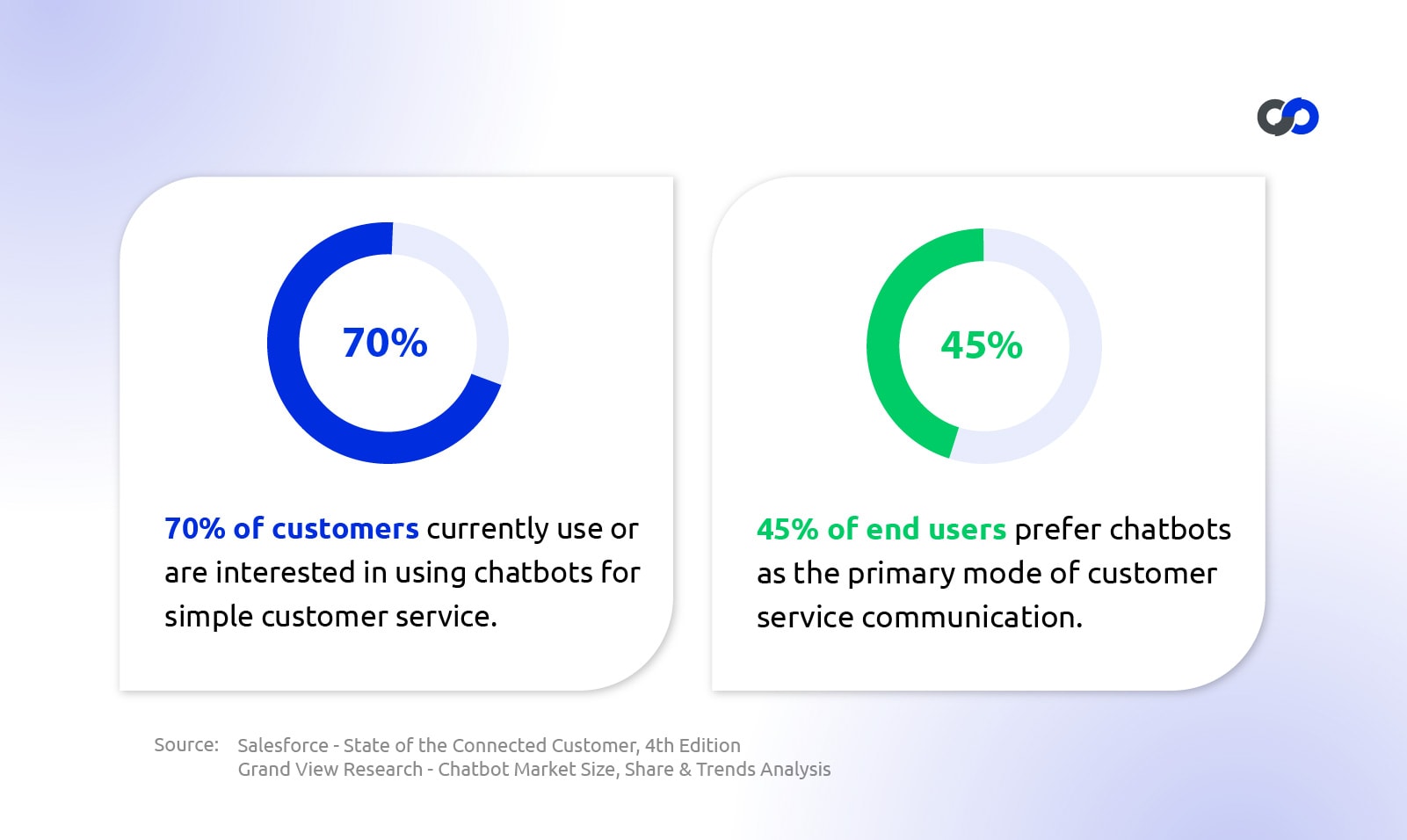
Chatbot apps don’t just benefit the end consumer. Chatbots can also reduce manual work and improve efficiency by automating a significant portion of frontline customer service requests. When built well, chatbots reduce support costs. Find out how much money a chatbot could save your organization with our Chatbot ROI Calculator.
If you are thinking of adopting chatbots into your customer service operations, you’ve come to the right place. In this guide, we’ll provide you with everything you need to know about chatbot apps, from their key benefits and popular use cases to how to build chatbots. With so much to dig into, let’s start by explaining what chatbots are.

As we get started in our guide on chatbot apps, it’s worth starting by answering some of the common questions among those new to this technology:
Chatbots are software that can hold online conversations using a familiar text interface. Often embedded within live chat software, chatbots are programmed to hold conversations with visitors without human involvement. The technology they are powered by depends on the type of chatbot – more on this in chapter 3.
The most basic of chatbot apps are often known as keyword chatbots. These are ‘trained’ from existing reference materials like a knowledge base or FAQ bank. The bot is then able to draw from these resources to answer frequently asked questions.
AI chatbots take chatbot responses to the next level through their understanding of intent, expressions and language. These AI-powered chatbots can understand conversational dialogue and more quickly identify what the requestor’s needs are. With AI driving their responses, the bots can improve their responses over time based on customer confidence in their answers. This is known as machine learning, since the bot can develop stronger answers over time according to real-world feedback.
Task bots are another effective type of chatbot. They are commonly used to automate routine tasks and workflows, allowing customers to complete requests through conversations instead of forms. Depending on need, these requests can include booking meetings, capturing contact details, or registering attendees for upcoming events.
In the next chapter, we’ll look at the benefits of chatbots.

With our introduction to chatbots out of the way, let’s look to the benefits of chatbots in customer service. In this chapter, we’ll look at how chatbot apps can transform the digital customer experience (CX) through improved service, availability, and accessibility, as well as the ROI they can generate for the organization through automation.
Thanks to the directness of modern technologies, today’s customers increasingly expect an immediate response from support. This trend doesn’t appear to be slowing down, either. 83% of customers now expect immediate engagement with someone when contacting a company, up from 78% in 2019.
Customers now often rate the quality of a response based on how fast the response is. When asked how important an immediate response is for customer support, 90% rated an immediate response as “important or very important”.
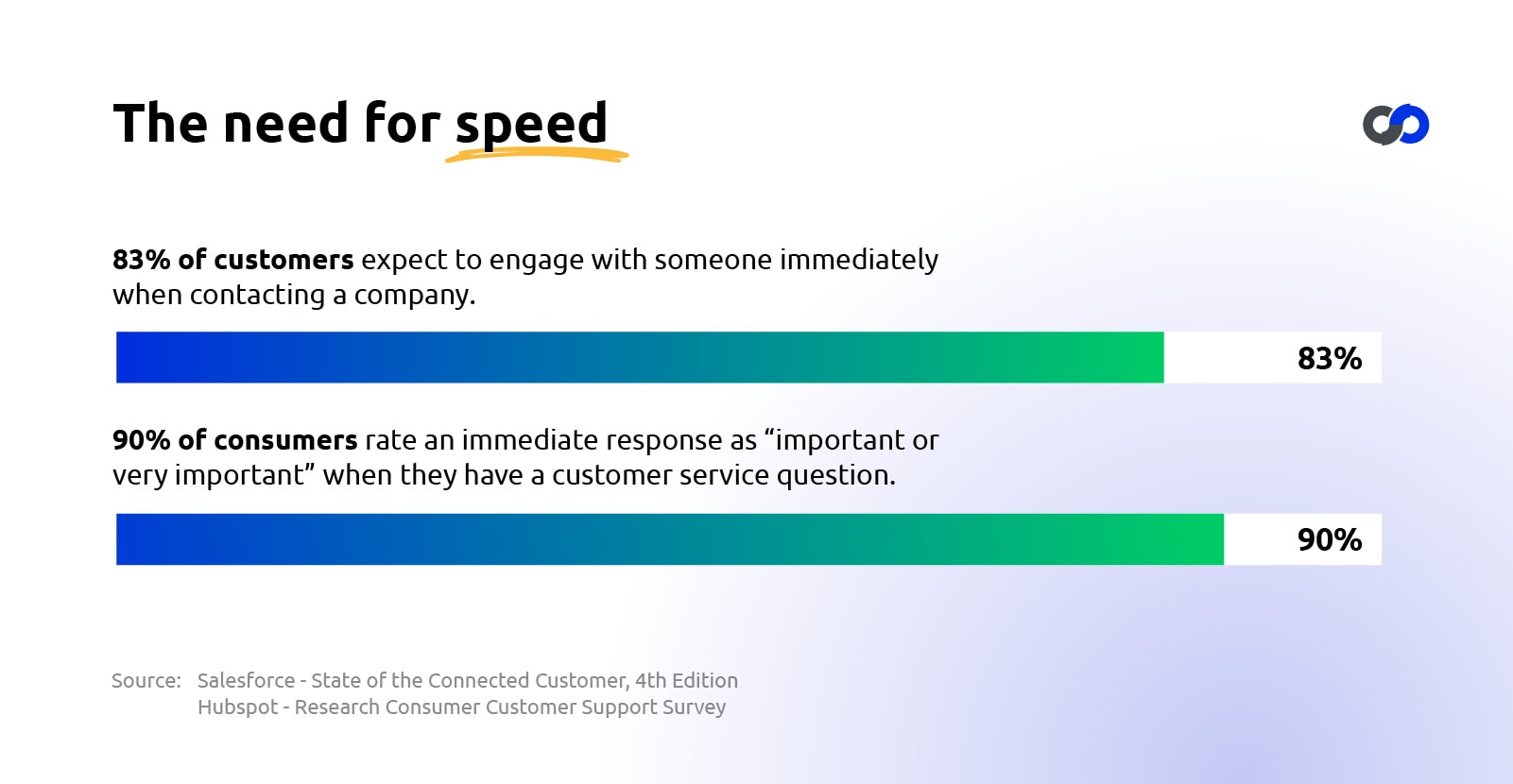
When customers demand an immediate response at any time, only chatbots can deliver. Unlike a human agent, chatbots respond immediately and have unlimited capacity. Best of all, because the high volumes typically handled by chatbots are simple requests like “what time does the store close?”, introducing a chatbot app does not harm the quality of service.
We’ve seen that customers want an immediate response to their issues, and today’s customers aren’t content to wait for “business hours” for a response. Agent costs have put 24/7 support out of reach for many organizations in the past. Providing cost-effective 24/7 support is just one of the many advantages of chatbot apps.
Just like during the day, AI-powered chatbots operating outside of standard working hours can handle an unlimited number of chats with no delay. With chatbots handling most simple requests without human intervention, customers can continue to receive excellent support at any time of day. In cases where a chatbot is unable to resolve an issue on its own, it can take a message so that agents can respond at their earliest availability.
The next benefit of chatbots that we’ll look at is the excellent return on investment. Insider Intelligence estimates that the adoption of chatbots could save the healthcare, banking, and retail sectors $11 billion annually by 2023. By handling the majority of queries, support agents can be deployed on other tasks. Alternatively, if support volumes rise, more agents aren’t needed to manage this increase.
Calculating ROI can be difficult, so thankfully Comm100 has provided a chatbot ROI calculator to assist organizations with breaking down potential cost savings. By entering agent numbers, average compensation, and chat details, it’s possible to see how many new agents are needed to compete with a single chatbot with unlimited capacity.
“The bot has allowed us to not only effectively manage the increase in chat volume, but it has also saved us a considerable amount of money by not having to hire a lot more agents.” – Richard Branson, COO at Tangerine
Read more: Comm100 Chatbot Resolves 91% of Assigned Live Chats for Tangerine
It might seem counterintuitive that automating customer responses will improve CX. However, not all customer interactions are created equal. Chatbots excel at handling simple and repetitive requests, and Comm100 chatbots can resolve up to 91% of queries without any human involvement. Chatbot responses have no delay, meaning an improved customer experience and lower wait times for all kinds of requests. With these chatbot app advantages, it’s not surprising that 70% of customers currently use or are interested in using chatbots for simple customer service.
With the simple requests taken care of, agents have lower volume to work through and so more time for high value work. Agents can spend more of their time devoted to each customer, leading to more attentive support and an improvement in service quality.
“For us, the chatbot wasn’t launched to reduce agent headcount. It was launched so our agents can spend less time on simple queries, and more on the complicated and high-value queries… It’s thanks to Comm100 Chatbot that we can give more time and care to our donors.” – Denny Michaud, Customer Relations Manager at Canadian Blood Services
Information can be difficult to find in even the most well-kept support materials, and time is always at a premium to customers needing help. For customers seeking a self-service option, introducing a chatbot allows customers to reach the information they want more quickly. 90% of customers surveyed say that they want a convenient experience when they interact with a brand online, and on the web that often means removing barriers to information.
In a survey of US citizens interacting with Federal agencies, more than 65% said they preferred self-service options over speaking with someone. These results aren’t unique, and one of the benefits of chatbots in customer service is allowing customers to ask a simple question, receive the answer, and leave. When more complex instructions are needed, chatbots can easily link to existing resources for faster answers.
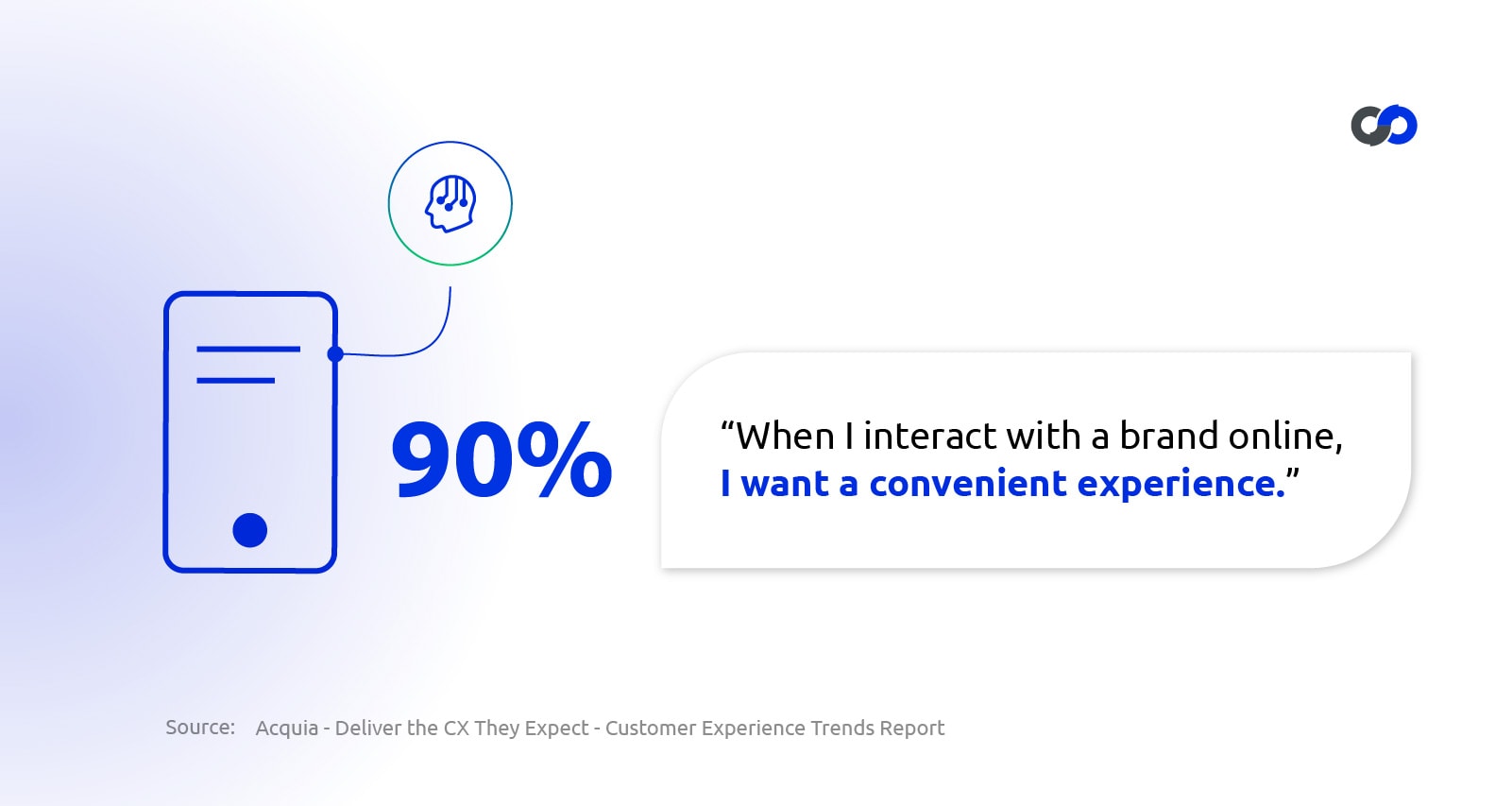
While most benefits of chatbots that we’ve looked at so far are felt by customers, the benefits of chatbots for business also extend to the agent experience. By handing over the repetitive queries to a bot, agents can spend their time on more fulfilling work, which can in turn improve their performance.
Working in customer support can be challenging, and 87% of contact center agents report high or very high levels stress levels. With significant turnover seen across all industries, improving the working conditions for staff has never been more important. As Canadian Blood Services, Denny Michaud explained:
“Customer service can be a tough job for frontline agents, so it’s really important for us to make sure that we are doing everything we can to improve their everyday experience. Comm100 Live Chat helps a lot, and the chatbot even more. Before the chatbot, our agents were having to answer the same simple questions over and over again. With a chatbot now handling the vast majority of these questions, this is no longer an issue and our agents feel more engaged and fulfilled in their roles.”

Now that we’ve explored the benefits of chatbots, in this chapter we’ll look at the types of chatbot on the market to see how they differ and which would best suit your needs. The uses of each bot differ so take this into account when thinking about what chatbot success metrics are important to you.
Many organizations begin their chatbot journey with task bots. These bots guide customers through a series of questions and answers using a series of buttons to resolve their query or complete a task. Task bots can use text, images, videos, links, and more to create a dynamic response that is engaging.
Here are some examples of what task bots can do:
As well as automating manual and time-consuming requests, task bots also let companies deliver 24/7 support without spending thousands of dollars hiring new staff or outsourcing to an international customer service provider. This improves CX, as well as engagement and lead generation.
Task bots are often a good place to start in your chatbot journey because they are incredibly easy to build and require no coding. You can simply choose from a selection of templates or build your own with an intuitive drag-and-drop functionality. More on this in Chapter 5.
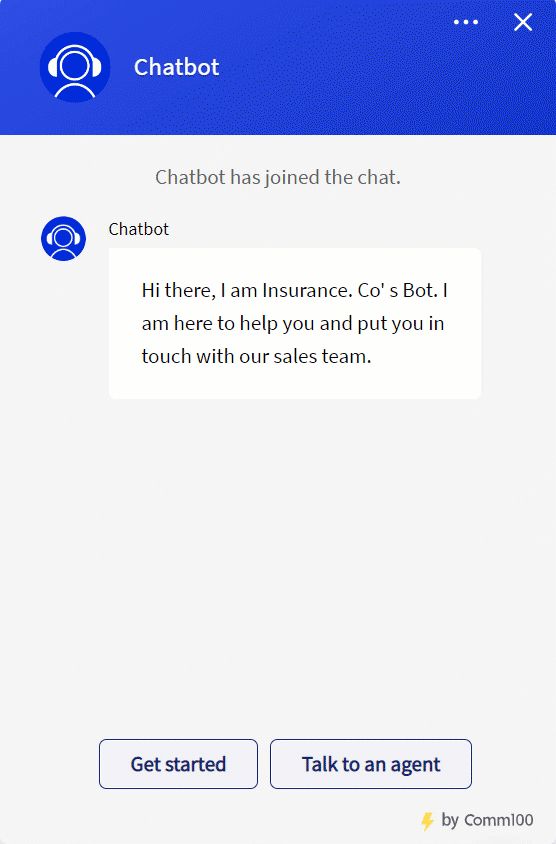
AI chatbots are powered by artificial intelligence, so rather than just following a pre-set range of questions and answers, they can also understand intent and complexities of language. This means they can engage in more natural conversations and handle more complex questions. Rather than just serving as an interactive FAQ, AI-powered chatbots can also take action and help customers accomplish tasks like booking meetings or making payments.
Comm100 AI Chatbot can handle up to 91% of queries without any human interaction, as it is doing for Tangerine Telecoms.
Conditional Logic is an intelligent feature some AI-powered chatbots offer that makes it possible to personalize every customer interaction based on a customer’s profile and relationship with the business. This lets you deliver high-quality and personalized service without building and maintaining multiple chatbots.
AI-powered chatbots shouldn’t be difficult to build either. Comm100 AI Chatbot boasts an easy-to-use, code-free UI so with a little initial support, people without programming knowledge can build an AI-powered chatbot.
“I don’t have a computer science or programming background so finding a chatbot that was simple to build and code-free was crucial – and Comm100 Chatbot delivered on this. With a little learning and guidance from Comm100’s bot architect team, I built our bot from scratch with no technical knowledge. I think anyone who has a social media account can build a Comm100 Chatbot.” – Lachlan Todd, Communications & Systems Coordinator, Thompson Rivers University
Continuing our journey into AI-powered chatbots, we’ll next look at some common use cases for chatbots across industries.

The benefits of chatbots are abundant, and so too are chatbot use cases. In this chapter we will show you some of the most common chatbot customer service use cases across industries, exploring chatbot examples that you too can adopt within your organization.
If you want more inspiration, here are even more chatbot customer service use cases for every industry.
Chatbot apps are the most cost-effective tool for universities and colleges looking to increase student intake. By offering prospective students the ability to get support 24/7 via a fast and convenient channel, schools can connect with more students and begin developing relationships with them that can turn into admissions.
Cambrian College is a great chatbot example of this. The Canadian college recognized that many prospective students were trying to connect with them outside of the typical 9-5 business hours, particularly international students in different time zones. Not able to afford hiring more agents or extending their support hours, Cambrian College chose to set up Comm100 AI Chatbot within their recruitment department. Set up to answer the most common FAQs 24/7, the bot now handles over 70% of all incoming chats. The rest are handled by the support staff on live chat.
The result? The college now engages with more prospective students and has increased enrolment – from national and international students alike.
“Our AI chatbot was going to be active when live agents couldn’t be so we wanted to make sure that he could provide the level of customer service that we expected from everyone in our Recruitment department.” – Alison Caruso, Manager of Student Recruitment, Cambrian College,
Read the full story: Cambrian College Improves Recruitment with Comm100 Live Chat & Chatbot
The decision to join a credit union often isn’t purely driven by money. Members may have direct connections with their unions or value its not-for-profit status. As a result, members often have high expectations when it comes to member support.
To deliver on these expectations, Lake Michigan Credit Union implemented Comm100 Live Chat in 2015, and Comm100 Chatbot soon after. While they pride themselves on developing connections with their members, they also recognized how beneficial chatbot support would be to their members by providing them with support on the weekends when their support team is offline.
The chatbot also improves member support for those who would rather speak to an agent. When the team is online, the bot handles a high portion of queries, which results in lower queue lengths and wait times for members wanting to chat with an agent.
“The process of building the chatbot was great. We’ve had a very positive relationship with Comm100 for over five years and their bot team was as helpful as ever. They supported us throughout the build and deployment and gave us a lot of advice and best practice to make sure that our chatbot is a success.” – Jasmina Duric, Manager of E-Services and Support Department
Read the full story: Lake Michigan Credit Union scales better member engagement with Comm100 Live Chat & AI Chatbot
Chatbot customer service use cases abound in the healthcare industry, but one of the most common chatbot examples is reducing wait times. With an immediate response and the ability to handle unlimited simultaneous chats, chatbots can significantly reduce wait times.
Canadian Blood Services introduced a chatbot to take care of the common FAQs that were taking up their agents’ time. 70% of chats are routed to the bot, of which 68% are resolved without human interaction. The result is two-fold. Firstly, wait times have decreased to only 16 seconds as the majority of queries are resolved without any human intervention. Secondly, customer satisfaction (CSAT) has increased to 4.5 out of 5 as visitors who want to speak to an agent can now be given more time and care, allowing for more meaningful and helpful conversations.
“Our average chat length increased after implementing Comm100 Chatbot – but this is exactly what we expected, and hoped for! Longer chat duration shows us that our agents are dealing with more complex questions and are having more meaningful conversations with our donors. Donor experience is so important to us – every conversation matters, and the last thing that we want to see are rushed conversations that could come across like we don’t care. It’s thanks to Comm100 Chatbot that we can give more time and care to our donors.” – Denny Michaud, Customer Relations Manager at Canadian Blood Services
Read more: Canadian Blood Services Improves Customer & Agent Experience with Comm100 AI Chatbot
Chatbot apps are ideal for improving efficiency in support environments through their ability to automate repetitive tasks. Alberta School Employee Benefit Plan (ASEBP) provides us with a unique but effective chatbot example of this.
ASEBP prides itself on providing fast support to its clients. However, in 2020 they recognized that their operations could be much more efficient and so introduced Comm100 Chatbot as an internal agent-facing tool. Rather than forcing the agent to spend long amounts of time manually searching through a spreadsheet to find the answers to client questions, the agent can type the question into the chatbot interface hosted on an internal web page. The bot then provides the answer to the agent who can quickly and confidently pass this on to the client.
This improves the experience for both agent and client. The chatbot is incredibly popular with agents, boasting an impressive CSAT score of 4.8 out of 5. On the other hand, wait time has dropped to only 14 seconds and clients are receiving answers faster.
“We have been so impressed with the positive impact that Comm100’s tools have had for our staff. Our staff love it – it’s really easy to use and makes them feel so much more confident in their role, with far less chance of error. This then trickles down onto our members who receive quicker and more accurate support and trust in us – I’m not sure what we would do without it now!” – Katherine Gaetz, Manager, Member Experience at AESBP
If you have seen the light and want to implement a chatbot into your website, here’s a list of 6 of the best AI chatbots with detailed comparisons, reviews, and feature lists.

Before you can begin building your chatbot, you need to decide what you want your bot to achieve as this will determine what bot you will need to build. You can answer this question by asking yourself what business outcomes you’d like to achieve. As we’ve seen throughout this guide, some chatbot goals include:
Depending on your goals, you can either build a task bot or an AI chatbot. Task bots are simple-to-build bots that are code-free and often a great place for companies to begin their chatbot journey. AI chatbots do require more work to set up but with the right support from your vendor, are straightforward to build too. If you want an AI chatbot, make sure that you understand what support your vendor will offer, either giving you the tools to build it yourself, building it for you, or a combination of the two.
Once your goals for your chatbot are clear and you’ve defined the parameters, you can move on to building the chatbot. The best data to train your bot comes from the resources you’ve already built, including chat scripts, your knowledge base, and FAQs. Using what you already have available will speed up the timeline for the bot’s deployment.
1. To start creating a new task bot, simply log into the Comm100 platform and select “New Task Bot” from the Dashboard.
2. Next, decide whether you want to build a chatbot from scratch or choose from one of four templates:
3. Task bot templates will come with sample greetings and buttons, or you can customize the conversation workflow by deciding the actions your task bot will take, including:
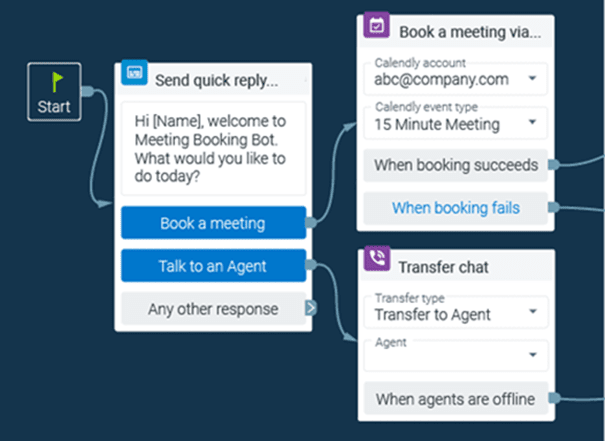
4. Once the workflow is set, you can either choose a template conversation flow, or design the flow to tell your task bot how to:
5. When it’s ready to go live you can choose whether your chatbot will act as a pre-chat function or an offline message. With the pre-chat function enabled, your chatbot will respond to all incoming queries, including during business hours. With your task bot set as an offline message, it will only be live when agents are offline, acting as an after-hours assistant.
6. With the parameters set, you can now preview your bot for a simulated interaction and make any final edits. When your chatbot is ready, you can set it to go live via Comm100 Live Chat.
1. To begin creating a Comm100 AI Chatbot, first log into the Comm100 control panel and select New Chatbot from the Dashboard.
2. Configure the settings for your bot, starting with a name and language. Next, you’ll set:
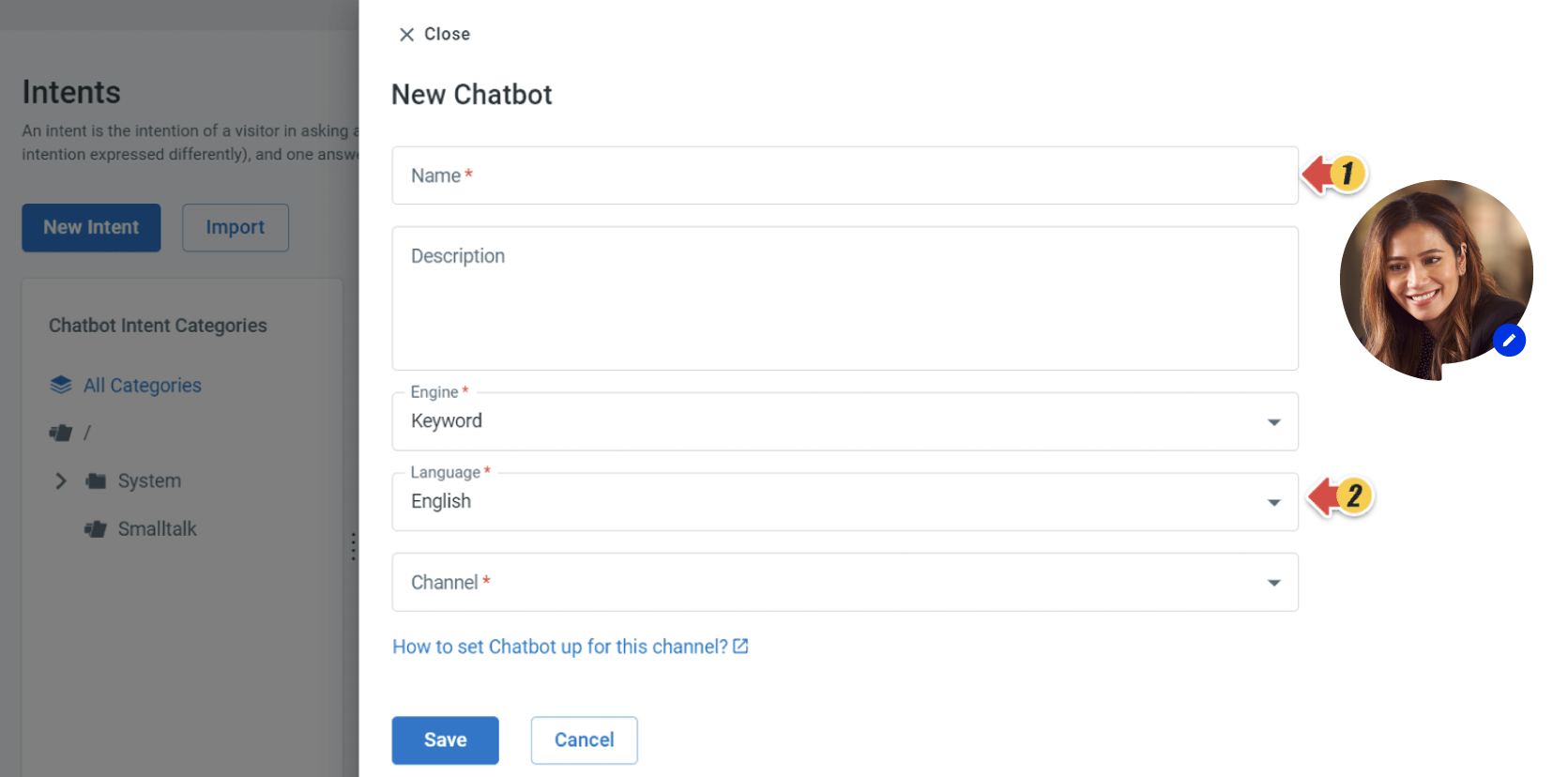
3. With the settings dialed in, you’ll choose which channels to enable the chatbot on. In this example, we’re looking at how to build a chatbot for Comm100 Live Chat.
4. From the left navigation menu of the Comm100 control panel, go to Live Chat and then select Campaign. Choose a campaign from the drop-down list and go to Chatbot, where you’ll enable the Chatbot toggle key.
5. From the Bot for Campaign drop-down list, select your bot.
6. Here you’ll define how chats are distributed to the bot. You can choose to allocate chats to the bot either when agents are online or offline. When agents are online, you can allocate chats by defining a queue length or setting the percentage of distribution. When agents are offline, all chats are allocated to the chatbot in this case.
7. With chats allocated, your AI Chatbot is ready. Click Save and you’re done!
For more detailed instructions on how to build a chatbot, with screen captures of each step, Comm100 has the following resources:
How to Build a Chatbot in 8 Steps Without Coding
How to Create a Comm100 Chatbot
Now that you’ve seen the benefits of chatbot across any industry, you’re ready to introduce a chatbot to your organization. Bringing a chatbot to your support team will mean:
There’s never been a better time to bring automation to your workplace with a chatbot app. To see how Comm100’s chatbot app can transform your operations, book a demo with one of our bot specialists today.
There’s a lot more where this came from!
Get our monthly customer service news and best practices update delivered to your inbox.

Article by
Kate is the Content Marketing Specialist at Comm100. She has extensive experience in content creation for technology companies across the world, including the UK, Australia and Canada. She specializes in B2B messaging, branding and soccer trivia.